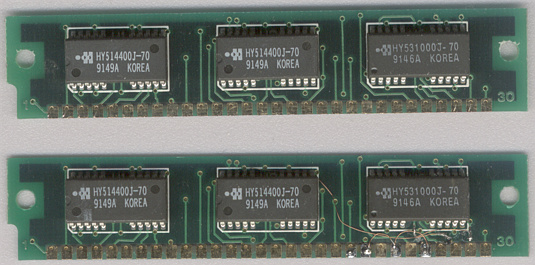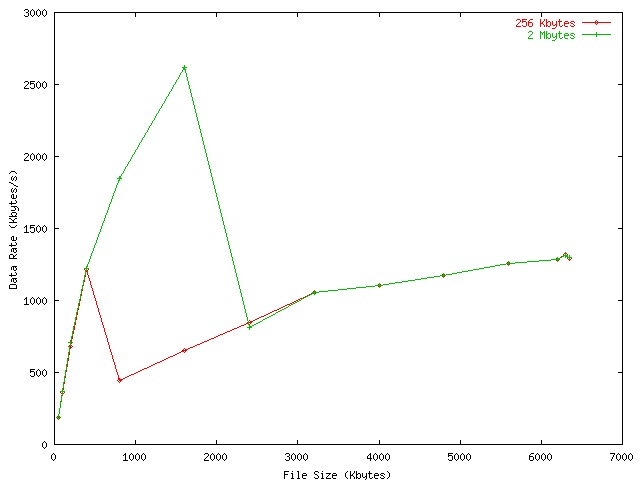|
Preface
Spock
IBM SIMMs
Warm Up Your Soldering Iron!
The Reward
Summary
Content © Alfred Arnold, 2002 (original HERE). Edited by Major Tom.
Preface
SCSI has been the disk interface of choice for most of IBM's Micro Channel
PS/2 machines, except the first generation that either used ST-506 or ESDI
disks or some late desktop models with IDE. IBM quickly targeted them to the
high-end and server market since the Micro Channel was not successful in the
mass market. This and the fact that IBM has always put an emphasis on 'balanced
systems' with an I/O performance growing with the CPU's power drove the
development of SCSI controllers with separate cache memory.
Spock
One common example is the 'SCSI Controller with Cache', also known by its
code name 'Spock'. It is a 32-bit busmaster with 512 KB of local cache RAM,
organized as two 30-pin SIMMs of 256Kx9. The RAM is controlled by a local 80188
or 80186 microprocessor. A rarely known fact is that the controller can be
extended to 2 MB by replacing the SIMMs with 1 MB types. So you simply take two
SIMMs out of your junkbox, put them in, and...typically get a glorious error
message and nothing works.
IBM SIMMs
Of course it would have been too simple for IBM to take 'industry standard'
SIMMs. They used SIMMs with a different parity pinout and additional presence
detection pins. The latter ones allow the computer to detect a SIMM's size
automatically, without having to probe all possible sizes. In detail, there are
the following differences between the standard and IBM pinout:
| Pin | Industry Std. | IBM |
|---|
| 2 | Data CAS | Data & Parity CAS |
| 24 | Not Connected | Presence Detect |
| 26 | Parity Data Out | Presence Detect |
| 28 | Parity CAS | Not Connected |
| 29 | Parity Data In | Parity Data In/Out |
The two presence detect pins allow the following combinations:
| Pin 24 | Pin 26 | Capacity |
|---|
| open | open | no module inserted |
| open | grounded | 512Kx9 |
| grounded | open | 256Kx9 |
| grounded | grounded | 1Mx9 |
These modules have not only been used for the cached SCSI controller, but
also in some early PS/2 machines for main memory, namely in the ISA-based Model
30-286, and the MCA-based 50/60 (not the newer 50Z which already uses
72-pin modules). Watch out however to use the correct type of modules for this
purpose, see below!
Warm Up Your Soldering Iron!
So to convert an industry-standard SIMM to an IBM-style SIMM, the
following has to be done:
- cut the connection between SIMM pin 26 and the parity chip's Data Out
pin;
- connect the parity chip's Data Out pin to SIMM pin 29;
- cut the connection between SIMM pin 28 and the parity chip's CAS
pin;
- connect the parity chip's CAS pin to SIMM pin 2;
- connect both SIMM pins 26 and 24 to SIMM pin 22 (GND).
In my experience, these modifications are simpler if you use 1M SIMMs built
with 3 chips instead of 9; the three chips occupy less space on the module's
PCB, and it is easier to get access to the connections. However, if you are
going to modify modules to extend a Model 30 or 50, you will have to use 9-chip
modules; The memory controllers of these old systems do not provide enough
refresh address lines for the higher-capacity 1Mx4 chips on a 3-chip module,
and you will experience strange memory errors with them. Not all 9-chip modules
can be modified; the high chip density leads to a complex layout, and some of
the traces that have to be cut might be located in inner layers...
Shown below are two SIMMs; one unmodified and a SIMM that has been modified
according to the instructions above.

Click here or click onto
the photo for a full size version of this picture.
Another sample modified by Jim Shorney
These modules are typical for 3-chip industry-standard SIMMs. They consist
of two 1Mx4 chips for the data (the 514400 chips) and an extra 1Mx1 chip (the
531000 in this case) for the extra parity bit. This in sum makes the usual 1Mx9
people are talking about...the names of the individual chips may vary wildly
from module to module since the DRAM manufacturers are quite creative at this
:-)
Luckily, there are ANSI standards for RAM chip pinouts, so I can give you a
schematic rewiring plan here, both for 3-chip and 9-chip modules. The red lines
show connections to be added, while the fat double red lines symbolize
connections to be cut. Of course, there are more traces on a SIMM than the ones
shown, but I left the ones out that need not be modified to make things a bit
simpler.


Caution! The pinouts of the individual chips apply
only to your SIMMs if the chips are housed in the same case type (called 'SOJ')
as for my modules!
The Reward
After two modules have been modified in this manner, it is time to insert
the modified modules into the SCSI controller and to power it up. Of course,
such operations always bear a risk and - as you might guess - I disclaim all
responsibility for controllers that break... if this is your one-and-only Micro
Channel SCSI controller, it might be wiser to buy the correct modules from IBM
(or scavenge them from a Model 30-286 or Model 50/60). If everything went
right, your PS/2 should boot up as usual and report an error 174 (equipment
change). After the usual autoconfiguration, it's time to make some
measurements. I used cthdben, a DOS program from the German computer
magazine c't that measures the data rate for linear and random accesses. Since
Spock's cache is write-through, there are only improvements for read accesses
with a working set smaller than the cache size. The PS/2 used for the
measurements is a PS/2 8595-AKF upgraded to a 486DX2 CPU (66 MHz). The disk is
an old HP 1 Gig monster (5,25 inch, full height) that maxes out at
approximately 2 MB/s. The first figure shows the average data rate for random
accesses with 1/10th of the total file size:

For file sizes smaller than 256 KB or larger than 2 MB, the results do not
differ: Either the working set fits into both sizes, or it is to large for
both. The differences in the area between these margins is however remarkable:
They result both from the higher RAM-to-RAM than Disk-to-RAM data rate and from
the lower access time (the half rotation needed in average before the first
data sector comes by is eliminated plus the SCSI protocol overhead). One can
extrapolate that for a larger cache, the curve could well extend into the range
of 5 to 10 MB per second. However, Spock has no provisions to use 4 MB modules;
honestly said, I was already surprised that 2 MB cache work. The 80188
processor only has a 1 MB address space so there must be some sort of bank
switching mechanism on the controller's memory interface; this wouldn't have
been necessary for a 512K-only design.
Looking at linear accesses, the differences are not as impressive, but still
visible:

Though the cache cannot avoid repeated disk accesses to the same disk
sectors, there is still a gain from the cache due to its read ahead
capability: the controller reads data in larger chunks than the main CPU really
requests them, and when the next chunk is requested, the controller can already
deliver its beginning without overhead. Operation with no or too few cache is
not as bad as in the random case as the drive's head only have to move by one
cylinder.
Summary
These are only synthetic benchmarks; your mileage in practical applications
may vary. Modern operating systems like Linux or NT already have dynamic disk
caches that automatically use free main memory, and of course copying in main
memory is even faster than transferring data over the MCA bus. I'd say it is a
nice extension if you have 30-pin SIMMs collecting dust otherwise and if you
have fun in hardware hacking. If you'd have to buy the modules, better invest
the money in main memory ;-)
|